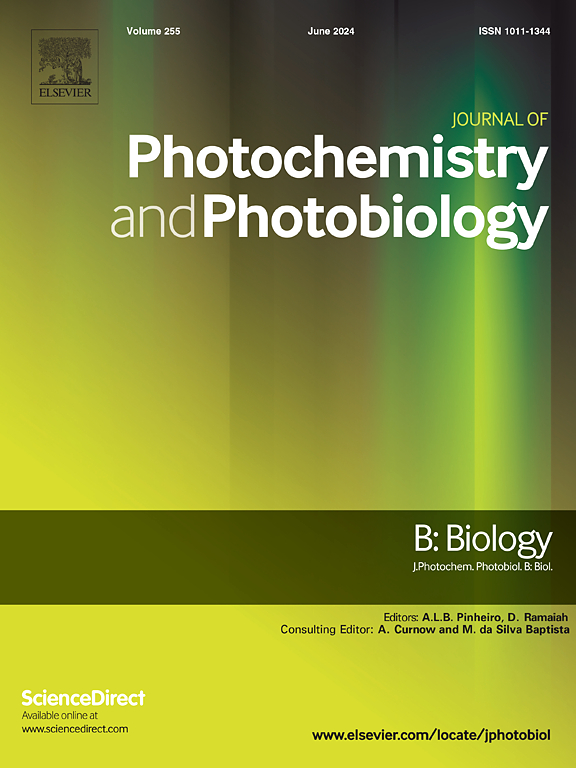Enhanced photodynamic therapy with riboflavin@ dual minerals doped hydroxyapatite nanoparticles: A promising in vitro approach for bladder cancer
IF 3.7
2区 生物学
Q2 BIOCHEMISTRY & MOLECULAR BIOLOGY
Journal of photochemistry and photobiology. B, Biology
Pub Date : 2025-06-27
DOI:10.1016/j.jphotobiol.2025.113207
引用次数: 0
Abstract
This research examines the efficacy of pure dual minerals (cerium and zinc) doped hydroxyapatite DHA and riboflavin (RFA)-coated DHA nanoparticles (NPs) (RFA@DHA NPs) in the treatment of bladder cancer. X-ray diffraction and Fourier-transform infrared spectroscopy validated the successful coating of RFA while preserving the core crystal structure of DHA. High-resolution transmission electron microscopy demonstrated the presence of spherical NPs, which exhibited a minor increase in size following RFA coating. Both NPs formulations exhibited significant concentration-dependent anticancer activity against T24 bladder cancer cells in the absence of UV irradiation, with RFA@DHA showing superior efficacy (IC50 values of 36.3 and 38.6 μg/mL, respectively). UV irradiation enhanced the effects of photodynamic therapy (PDT), with RFA@DHA demonstrating greater cytotoxicity (IC50 values of 27.9 and 32.6 μg/mL for RFA@DHA and pure DHA, respectively). Live/dead cell assays and nuclear condensation assays demonstrated that both NPs induced apoptosis in a time-dependent manner. The RFA coating mechanistically increased the production of reactive oxygen species (ROS) in both dark conditions and under UV irradiation, resulting in a notable disruption of the mitochondrial membrane potential, which is a critical event in the apoptotic pathway. The findings indicate that RFA-coated DHA NPs may serve as effective photosensitizers for bladder cancer therapy.
核黄素双矿物质掺杂羟基磷灰石纳米颗粒增强光动力治疗:膀胱癌的体外治疗方法
本研究考察了纯双矿物质(铈和锌)掺杂羟基磷灰石DHA和核黄素(RFA)包被DHA纳米颗粒(NPs) (RFA@DHA NPs)治疗膀胱癌的疗效。x射线衍射和傅里叶变换红外光谱验证了RFA涂层的成功,同时保留了DHA的核心晶体结构。高分辨率透射电子显微镜显示球形NPs的存在,在RFA涂层后,其尺寸略有增加。两种NPs制剂在没有紫外线照射的情况下,对T24膀胱癌细胞的抗癌活性均表现出明显的浓度依赖性,其中RFA@DHA的IC50值分别为36.3和38.6 μg/mL。紫外线照射增强了光动力疗法(PDT)的效果,RFA@DHA显示出更大的细胞毒性(RFA@DHA和纯DHA的IC50值分别为27.9和32.6 μg/mL)。活/死细胞实验和核凝聚实验表明,这两种NPs都以时间依赖性的方式诱导细胞凋亡。RFA涂层在黑暗条件和紫外线照射下都增加了活性氧(ROS)的产生,导致线粒体膜电位的明显破坏,这是凋亡途径中的一个关键事件。研究结果表明,rfa包被的DHA NPs可能作为膀胱癌治疗的有效光敏剂。
本文章由计算机程序翻译,如有差异,请以英文原文为准。
求助全文
约1分钟内获得全文
求助全文
来源期刊
CiteScore
12.10
自引率
1.90%
发文量
161
审稿时长
37 days
期刊介绍:
The Journal of Photochemistry and Photobiology B: Biology provides a forum for the publication of papers relating to the various aspects of photobiology, as well as a means for communication in this multidisciplinary field.
The scope includes:
- Bioluminescence
- Chronobiology
- DNA repair
- Environmental photobiology
- Nanotechnology in photobiology
- Photocarcinogenesis
- Photochemistry of biomolecules
- Photodynamic therapy
- Photomedicine
- Photomorphogenesis
- Photomovement
- Photoreception
- Photosensitization
- Photosynthesis
- Phototechnology
- Spectroscopy of biological systems
- UV and visible radiation effects and vision.

 求助内容:
求助内容: 应助结果提醒方式:
应助结果提醒方式:


